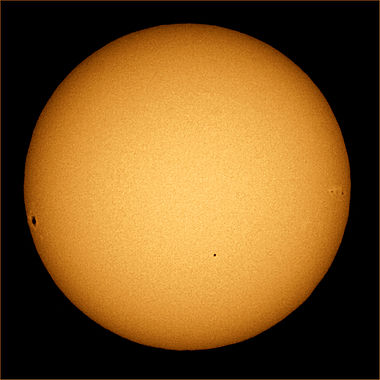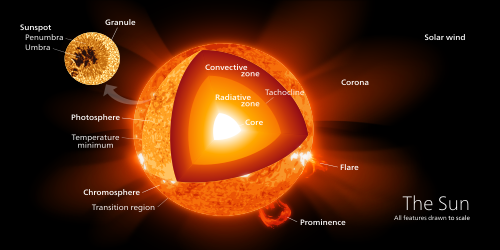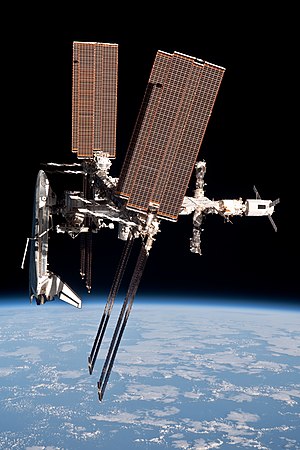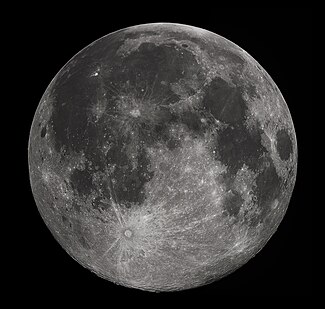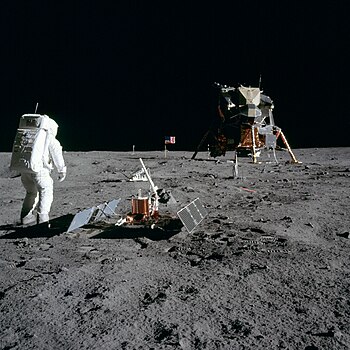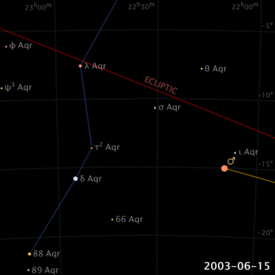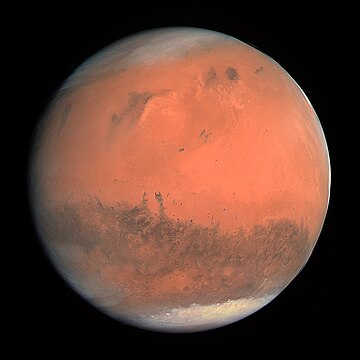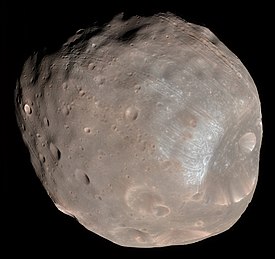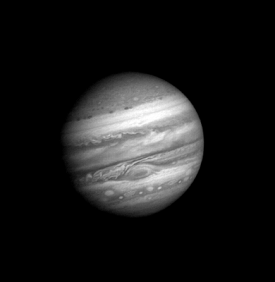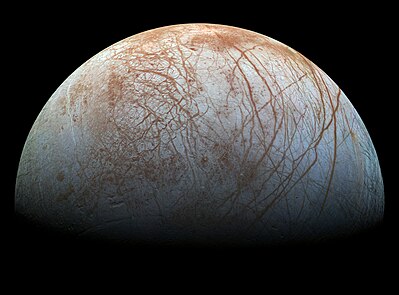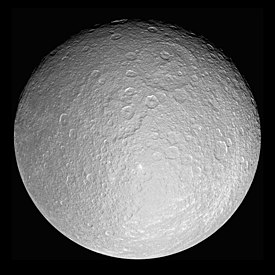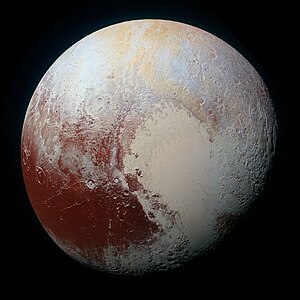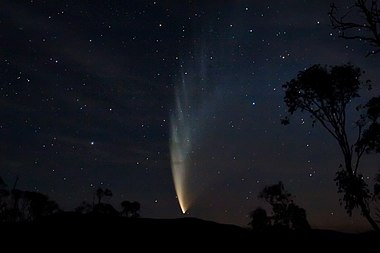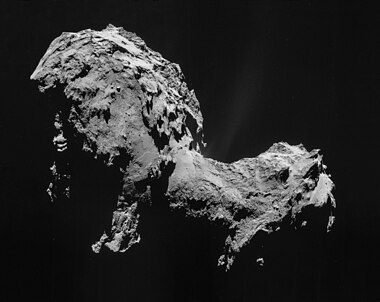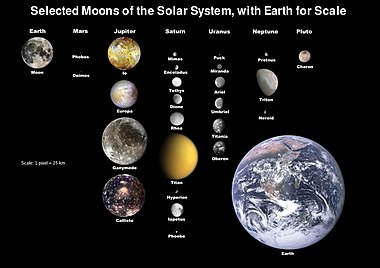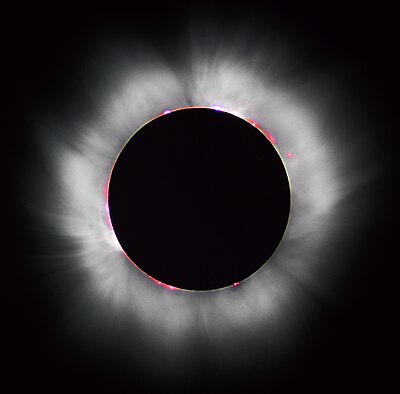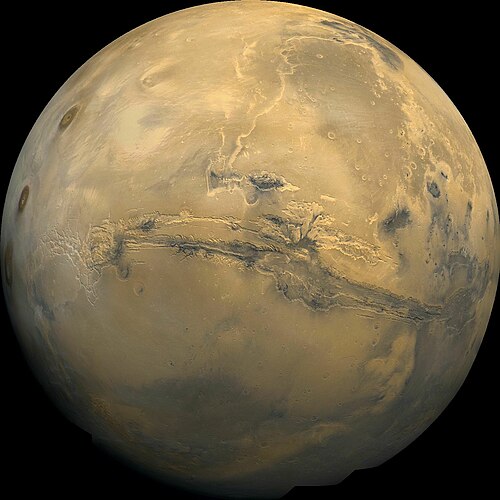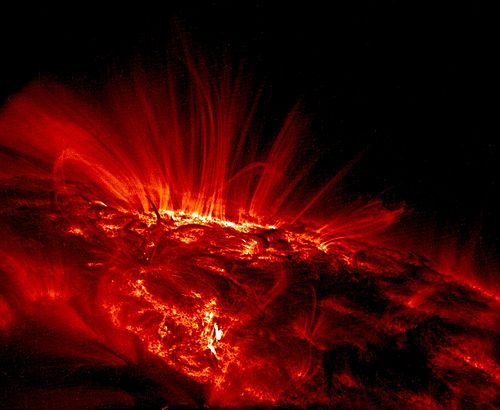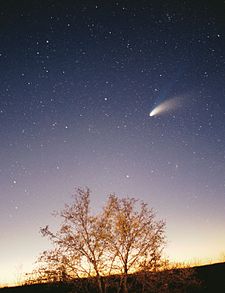Portal:Solar System/Selected picture
Appearance
The Selected picture box on the portal chooses one of the following at random when displaying the page. Follow the instructions below for adding or nominating a new picture to the list.
Picture candidates
[edit]Feel free to add related featured pictures to the list. Nominate other pictures on the portal talk page.
- Pictures must be
- Free to use and hosted on Commons
- Of good quality (not blurred, grainy or discoloured)
- Interesting
- Relevant to an article or topic
To find appropriate pictures, use search box below:
Instructions
[edit]- For pictures, which appeared as picture of the day on the Main Page, just add the date in
YYYY-MM-DDformat to the list (please keep the list sorted). - For other pictures, use following parameters:
|iN= |titleN= |creditN= |captionN=
where N is the next unused number.
Selected pictures list
[edit]The transit of Mercury across the face of the Sun that took place in November 2006. Mercury appears as a black speck in the Sun's lower center-right region; the black areas on the left and right edges are sunspots. The transit was first recorded by French astronomer Pierre Gassendi on November 7, 1631. Transits of Mercury take place in May or November, at intervals of 7, 13, or 33 years, with the next one scheduled to appear in May 2016.
A picture of the 2012 transit of Venus by the Solar Dynamics Observatory, from 36,000 km (22,000 mi) above the Earth. A transit of Venus across the Sun takes place when the planet Venus passes directly between the Sun and Earth. It is one of the rarest predictable astronomical phenomena and happens in pairs eight years apart that are separated from each other by 105 or 121 years. The last transit before 2012 was in 2004, and the next pair of transits will occur in 2117 and 2125.
A solar flare, a sudden flash of brightness observed over the Sun's surface or the solar limb which is interpreted as a large energy release, recorded on August 31, 2012. Such flares are often, but not always, followed by a colossal coronal mass ejection; in this instance, the ejection traveled at over 900 miles (1,400 km) per second.
The Sun is the star at the center of the Solar System. It is a nearly perfect sphere of plasma, heated by nuclear fusion of hydrogen into helium in its core, with internal convective motion that generates a magnetic field via a dynamo process. It is by far the most important source of energy for life on Earth. Its diameter is about 1.39 million kilometres (860,000 miles) or 109 times that of Earth, while its mass is about 330,000 times that of Earth. It accounts for about 99.86% of the total mass of the Solar System. Roughly three-quarters of the Sun's mass consists of hydrogen; the rest is mostly helium, with much smaller quantities of heavier elements, including oxygen, carbon, neon and iron.
This false-color photograph of the Sun was taken by the Atmospheric Imaging Assembly instrument on NASA's Solar Dynamics Observatory (SDO) at a wavelength of 304 angstroms, in the extreme ultraviolet region of the electromagnetic spectrum.
The Sun is the star at the center of the Solar System. It is a nearly perfect sphere of hot plasma, heated to incandescence by nuclear-fusion reactions in its core, radiating the energy mainly as visible light and infrared radiation. It is by far the most important source of energy for life on Earth. Its diameter is about 1.39 million kilometres (860,000 mi), or 109 times that of Earth. Its mass is about 330,000 times that of Earth, and accounts for about 99.86 percent of the total mass of the Solar System. Roughly three-quarters of the Sun's mass consists of hydrogen; the rest is mostly helium, with much smaller quantities of heavier elements, including oxygen, carbon, neon, and iron. This diagram illustrates the general structure of the Sun, with all features drawn to scale.
Mercury is the smallest and closest to the Sun of the eight planets in the Solar System. It has no known natural satellites. The planet is named after the Roman deity Mercury, the messenger to the gods.
Image credit: NASA
A radar image of the surface of Venus, centered at 180 degrees east longitude. This composite image was created from mapping by the Magellan probe, supplemented by data gathered by the Pioneer orbiter, with simulated hues based on color images recorded by Venera 13 and 14. No probe has been able to survive more than a few hours on Venus's surface, which is completely obscured by clouds, because the atmospheric pressure is some 90 times that of the Earth's, and its surface temperature is around 450 °C (842 °F).
Pale Blue Dot is the name given to this 1990 photo of Earth taken from Voyager 1 when its vantage point reached the edge of the Solar System, a distance of roughly 3.7 billion miles (6 billion kilometres). Earth can be seen as a blueish-white speck approximately halfway down the brown band to the right. The light band over Earth is an artifact of sunlight scattering in the camera's lens, resulting from the small angle between Earth and the Sun. Carl Sagan came up with the idea of turning the spacecraft around to take a composite image of the Solar System. Six years later, he reflected, "All of human history has happened on that tiny pixel, which is our only home."
Photo: NASA/ISS Expedition 23 crew
The aurora australis, as seen from the International Space Station. Aurorae are natural light displays in the sky caused by the collision of energetic charged particles with atoms in the high altitude thermosphere. The particles originate in the magnetosphere and solar wind and, on Earth, are directed by Earth's magnetic field into the atmosphere.
Photograph: Paolo Nespoli.
The International Space Station (ISS) is a space station in low Earth orbit, run as a joint project by the American, Russian, Japanese, European, and Canadian space agencies. Its first component was sent into orbit in 1998, and it has been inhabited continuously since 2000. The ISS consists of pressurised modules, external trusses, solar arrays, and other components, which have been launched by Russian Proton and Soyuz rockets, and American Space Shuttles. It serves as a microgravity and space environment research laboratory in which crew members conduct experiments in biology, human biology, physics, astronomy, meteorology, and other fields.
This photograph, taken in 2011 by Italian astronaut Paolo Nespoli from a departing Russian Soyuz spacecraft, shows the ISS and the docked Space Shuttle Endeavour.
Photo credit: Luc Viatour
Full moon is a lunar phase that occurs when the Moon is on the opposite side of the Earth from the Sun, and when the three celestial bodies are aligned as closely as possible to a straight line. At this time, as seen by viewers on Earth, the hemisphere of the Moon that is facing the Earth (the near side) is fully illuminated by sunlight and appears round. Only during a full moon is the opposite hemisphere of the Moon, which is not visible from Earth (the far side), completely unilluminated.
Photo credit: Harrison Schmitt
Astronaut Eugene Cernan makes a short test drive of the lunar rover (officially, Lunar Roving Vehicle or LRV) during the early part of the first Apollo 17 extravehicular activity. The LRV was only used in the last three Apollo missions, but it performed without any major problems and allowed the astronauts to cover far more ground than in previous missions. All three LRVs were abandoned on the Moon.
Image: Tom Ruen
An animation of the phases of the Moon. As the Moon revolves around the Earth, the Sun lights the Moon from a different side, creating the different phases. In the image, the Moon appears to get bigger as well as "wobble" slightly. Tidal locking synchronizes the Moon's rotation period on its axis to match its orbital period around the earth. These two periods nearly cancel each other out, except that the Moon's orbit is elliptical. This causes its orbital motion to speed up when closer to the Earth, and slow down when farther away, causing the Moon's apparent diameter to change, as well as the wobbling motion observed.
Model: Nickshanks
Lunar distance is a measurement of the distance from the Earth to the Moon. This diagram shows the distance, averaging 384,400 km (238,900 mi), to scale, as well as the Earth and the Moon (scroll to see the entire image).
Photograph credit: Gregory H. Revera
The Moon is the only natural satellite of Earth and the fifth largest moon in the Solar System. Owing to its synchronous rotation around Earth, the Moon always shows essentially the same face: its near side, which is marked by dark volcanic maria, as well as the bright ancient crustal highlands and the prominent impact craters. However, variations in the Moon's orbital speed due to its orbital eccentricity cause a libration of several degrees of longitude; the alignment of the Moon's orbital plane causes a similar libration in latitude. The Moon was first reached in September 1959 by the Soviet Union's unmanned Luna 2, followed by the first successful soft landing by Luna 9 in 1966. The United States Apollo program achieved the only manned lunar missions to date, including Apollo 8 in 1968, the first manned orbital mission, as well as Apollo 11, the first of six manned landings between 1969 and 1972.
This picture shows the near side of the Moon close to its greatest northern ecliptic latitude, so the southern craters are especially prominent. Tranquility Base, Apollo 11's landing site, is located near the mid-right in the photograph.
Photograph credit: Neil Armstrong
Tranquility Base is the landing site of the Apollo 11 mission on the Moon where, on July 20, 1969, humans first landed and walked on a celestial body other than the Earth. This photograph was taken at Tranquility Base by Neil Armstrong, the Apollo 11 commander, and depicts crewmember Buzz Aldrin with scientific equipment he had just deployed on the lunar surface. In the background on the right of the image is the lunar module, Eagle; the United States flag planted at the site during the mission was blown over the next day by the exhaust of the ascent rocket.
Photo credit: NASA
Mars, the fourth planet from the Sun, is named after the Roman god of war because of its blood red color. Mars has two small, oddly-shaped moons, Phobos and Deimos, named after the sons of the Greek god Ares. At some point in the future Phobos will be broken up by gravitational forces.
Victoria Crater, Mars
Photo credit: Mars Reconnaissance OrbiterVictoria Crater, an impact crater at Meridiani Planum, near the equator of Mars. The crater is approximately 800 meters (half a mile) in diameter. It has a distinctive scalloped shape to its rim, caused by erosion and downhill movement of crater wall material. Layered sedimentary rocks are exposed along the inner wall of the crater, and boulders that have fallen from the crater wall are visible on the crater floor. The floor of the crater is occupied by a striking field of sand dunes. The Mars rover Opportunity can be seen in this image, at roughly the "ten o'clock" position along the rim of the crater.
Photo credit: Mars Reconnaissance Orbiter
False-color Mars Reconnaissance Orbiter image of a side of the Chasma Boreale, a canyon in the polar ice cap of the Planum Boreum (north pole of Mars). Light browns are layers of surface dust, greys and blues are layers of water and carbon dioxide ice. Regular geometric cracking is indicative of higher concentrations of water ice.
The Planum Boreum's permanent ice cap has a maximum depth of 3 km (1.9 mi). It is roughly 1200 km (750 mi) in diameter, an area equivalent to about 1½ times the size of Texas. The Chasma Boreale is up to 100 km (62.5 mi) wide and features scarps up to 2 km (1.25 mi) high. For a comparison, the Grand Canyon is approximately 1.6 km (1 mi) deep in some places and 446 km (279 mi) long but only up to 24 km (15 mi) wide.
Photo credit: Spirit rover
A 360° panorama taken during the descent from the summit of Husband Hill, one of the Columbia Hills in Gusev crater, Mars. This stitched image is composed of 405 individual images taken with five different filters on the panoramic camera over the course of five Martian days.
Image credit: United States Geological Survey
A composite image of Olympus Mons on Mars, the tallest known volcano and mountain in the Solar System. This image was created from black-and-white imagery from the USGS's Mars Global Digital Image Mosaic and color imagery acquired from the 1978 visit of Viking 1.
Image credit: Seav
An animated image showing the apparent retrograde motion of Mars in 2003 as seen from Earth. All the true planets appear to periodically switch direction as they cross the sky. Because Earth completes its orbit in a shorter period of time than the planets outside its orbit, we periodically overtake them, like a faster car on a multi-lane highway. When this occurs, the planet will first appear to stop its eastward drift, and then drift back toward the west. Then, as Earth swings past the planet in its orbit, it appears to resume its normal motion west to east.
Photograph credit: European Space Agency
Mars is the fourth planet from the Sun and is known as the "Red Planet" due to its reddish appearance as seen from Earth. The planet is named after Mars, the Roman god of war. A terrestrial planet, Mars has a thin atmosphere and surface features reminiscent both of the impact craters of the Moon and the volcanoes, valleys, deserts and polar ice caps of the Earth. The planet has the highest mountain in the Solar System, Olympus Mons, as well as the largest canyon, Valles Marineris. Mars's rotation period and seasonal cycles are also similar to those of the Earth. Of all the planets in the Solar System other than Earth, Mars is the most likely to harbour liquid water and perhaps life. There are ongoing investigations assessing Mars's past potential for habitability, as well as the possibility of extant life. Future astrobiology missions are planned, including NASA's Mars 2020 rover and the European Space Agency (ESA)'s Rosalind Franklin rover. In November 2016, NASA reported finding a large amount of underground ice in the Utopia Planitia region of the planet. The volume of water detected has been estimated to be equivalent to the volume of water in Lake Superior. Mars has two moons, Phobos and Deimos, which are small and irregularly shaped.
This picture is a true-colour image of Mars, taken from a distance of about 240,000 kilometres (150,000 mi) by the OSIRIS instrument on ESA's Rosetta spacecraft, during its February 2007 flyby of the planet. The image was generated using OSIRIS's orange (red), green and blue filters.
Photograph credit: NASA / JPL–Caltech / University of Arizona
Although Mars is smaller than the Earth and 50 percent farther from the Sun, its climate has important similarities with the Earth, such as the presence of polar ice caps, seasonal changes and observable weather patterns. This image shows layered deposits in Planum Boreum, in the north polar region of Mars, which formed from a 3-kilometre-thick (2 mi) stack of dusty water-ice layers about 1,000 km (600 mi) across. The layers record information about the climate of the planet stretching back several million years. Erosion has created scarps and troughs that expose the layering. The tan-colored layers are the dusty water ice of the polar layered deposits, however a section of bluish layers is visible below them. These bluish layers contain sand-sized rock fragments that likely formed a large polar dunefield before the overlying dusty ice was deposited. This photograph, depicting an area approximately 1.3 km (0.8 mi) across, was captured by the HiRISE camera on board NASA's Mars Reconnaissance Orbiter.
Photo credit: Mars Reconnaissance Orbiter
Phobos, the larger and closer of the two moons of Mars, as seen from about 6,000 kilometres (3,700 mi) away. A small, irregularly shaped object, Phobos orbits about 9,377 km (5,827 mi) from the center of Mars, closer to its primary than any other planetary moon. The illuminated part of Phobos seen in the images is about 21 km (13 mi) across. The most prominent feature in the images is the large crater Stickney in the lower right. With a diameter of 9 km (5.6 mi), it is the largest feature on Phobos.
Photograph credit: NASA / OSIRIS-REx
101955 Bennu is a carbonaceous asteroid discovered by the Lincoln Near-Earth Asteroid Research project in 1999. Bennu has a roughly spheroidal shape, an effective diameter of about 484 m (1,588 ft), and a rough, boulder-strewn surface. It is a potentially hazardous object, with a cumulative 1-in-2,700 chance of impacting Earth between 2175 and 2199. It is named after the Bennu, an ancient Egyptian bird deity associated with the Sun, creation, and rebirth. This mosaic image of Bennu consists of twelve PolyCam images taken by NASA's OSIRIS-REx spacecraft from a range of 24 km (15 mi). The primary goal of the mission is to collect a sample from the asteroid's surface, which is scheduled to take place on October 20, 2020, and return the sample to Earth for analysis.
Photo credit: Voyager 1
False-color detail of Jupiter's atmosphere, imaged by Voyager 1, showing the Great Red Spot and a passing white oval. The wavy cloud pattern to the left of the Red Spot is a region of extraordinarily complex and variable wave motion. To give a sense of Jupiter's scale, the white oval storm directly below the Great Red Spot is approximately the same diameter as Earth.
Photo credit: Cassini orbiter
This polar map of Jupiter, taken by the Cassini orbiter as it neared Jupiter during a flyby on its way to Saturn, is the most detailed global color map of the planet ever produced. The south pole is in the center of the map and the equator is at the edge. The map shows a variety of colorful cloud features, including parallel reddish-brown and white bands, the Great Red Spot, multi-lobed chaotic regions, white ovals, and many small vortexes. Many clouds appear in streaks and waves due to continual stretching and folding by Jupiter's winds and turbulence.
An animated view of Voyager I's approach to Jupiter. One frame of this image was taken each Jupiter day (approximately 10 hours) between January 6 and February 9, 1979, as the space probe flew from 58 million to 31 million kilometers from Jupiter during that time. The small, round, dark spots appearing in some frames are the shadows cast by the moons passing between Jupiter and the Sun, while the small, white flashes around the planet, are the moons themselves.
Animation: NASA/JPL/University of Arizona
A 14-frame clip showing the atmosphere of Jupiter as viewed from the NASA probe Cassini. Taken over a span of 24 Jupiter rotations between October 31 and November 9, 2000, this clip shows various patterns of motion across the planet. The Great Red Spot rotates counterclockwise, and the uneven distribution of its high haze is obvious. To the east (right) of the Red Spot, oval storms, like ball bearings, roll over and pass each other. East-west bands adjacent to each other move at different rates. Strings of small storms rotate around northern-hemisphere ovals. The large grayish-blue "hot spots" at the northern edge of the white Equatorial Zone change over time as they proceed eastward across the planet. Ovals in the north rotate counter to those in the south. Small, very bright features appear quickly and randomly in turbulent regions, possibly lightning storms. The smallest visible features at the equator are about 600 km (370 miles) across.
Diagram: Kelvin Song
A diagram of Jupiter showing a model of the planet's interior, with a rocky core overlaid by a deep layer of liquid metallic hydrogen and an outer layer predominantly of molecular hydrogen. Jupiter's true interior composition is uncertain. For instance, the core may have shrunk as convection currents of hot liquid metallic hydrogen mixed with the molten core and carried its contents to higher levels in the planetary interior. Furthermore, there is no clear physical boundary between the hydrogen layers—with increasing depth the gas increases smoothly in temperature and density, ultimately becoming liquid.
Photo credit: New Horizons probe
An animation of an eruption by the Tvashtar Paterae volcanic region on the innermost of Jupiter's Galilean moons, Io. The ejecta plume is 330 km (205 mi) high, though only its uppermost half is visible in this image, as its source lies over the moon's limb on its far side. This animation consists of a sequence of five images taken by NASA's New Horizons probe on March 1, 2007, over the course of eight minutes from 23:50 UTC.
A true-color image of Io, one of the moons of Jupiter, taken by the Galileo spacecraft. The dark spot just left of the center is the erupting volcano Prometheus. The whitish plains on either side of it are coated with volcanically deposited sulfur dioxide frost, whereas the yellower regions contain a higher proportion of sulfur.
Realistic-color mosaic of images of Jupiter's moon Europa taken by NASA's Jupiter orbiter Galileo in 1995 and 1998. This view of the moon's anti-Jovian hemisphere shows numerous lineae, linear features created via a tectonic process in which crustal plates of water ice floating on a subsurface ocean (kept warm by tidal flexing) shift in relative position. Reddish regions are areas where the ice has a higher mineral content. The north polar region is at right. (Geologic features are annotated in Commons.)
Photo credit: Cassini orbiter
Saturn eclipsing the Sun, as seen by the Cassini orbiter. Individual rings seen in this image include (in order, starting from most distant): E ring, Pallene ring (visible very faintly in an arc just below Saturn), G ring, Janus/Epimetheus ring (faint), F ring (narrow brightest feature), Main rings (A,B,C), and D ring (bluish, nearest Saturn). Interior to the G ring and above the brighter main rings is the pale dot of Earth.
The Day the Earth Smiled refers to the date July 19, 2013, on which the Cassini spacecraft turned to image Saturn, its entire ring system, and the Earth from a position where Saturn eclipsed the Sun. Cassini imaging team leader and planetary scientist Carolyn Porco called for all the world's people to reflect on humanity's place in the cosmos, to marvel at life on Earth, and to look up and smile in celebration. The final mosaic, shown here, was released four months later and includes planets Earth, Mars, and Venus, and a host of Saturnian moons.
Photograph credit: NASA / JPL / Space Science Institute
The Cassini–Huygens space-research project involved a collaboration between NASA, the European Space Agency, and the Italian Space Agency to send a probe to study the planet Saturn and its system, including its rings and its natural satellites.
This natural-color mosaic image, combining thirty photographs, was taken by the Cassini orbiter over the course of approximately two hours on 23 July 2008 as it panned its wide-angle camera across Saturn and its ring system as the planet approached equinox. Six moons are pictured in the panorama, with the largest, Titan, visible at the bottom left.
Lakes of methane on Titan
Image credit: Cassini orbiterThis false-color radar image taken by the Cassini orbiter provides convincing evidence for large bodies of liquid methane on Titan. Images taken during a fly-by of the moon on July 22, 2006 show more than 75 large bodies of liquid ranging in diameter from three to 70km (1.9 to 43.6 mi) in the moon's northern hemisphere. Intensity in this colorized image is proportional to how much radar brightness is returned. The lakes, darker than the surrounding terrain, are emphasized here by tinting regions of low backscatter in blue. Radar-brighter regions are shown in tan. Smallest details in this image are about 500 m (1,640 ft) across. On January 3, 2007, NASA announced that scientists have "definitive evidence of lakes filled with methane on Saturn's moon Titan."
Photo credit: Cassini orbiter
Hyperion, a moon of Saturn, is one of the largest highly irregular (non-spherical) bodies in the Solar System. Enhanced image processing was used to bring out details and color differences in this photo taken by the Cassini orbiter. Hyperion is entirely saturated with deep, sharp-edged craters that give it the appearance of a giant sponge. Dark material fills the bottom of each crater.
Photo credit: Cassini orbiter
A close-up of 10 km (6.2 mi) high mountains within the equatorial ridge on Saturn's moon Iapetus, photographed by the Cassini orbiter. Above the middle of the image can be seen a place where an impact has exposed the bright ice beneath the dark overlying material. The image was taken on September 10, 2007, with the Cassini spacecraft narrow-angle camera at a distance of approximately 3,870 km (2,400 mi) from Iapetus.
Photo credit: Cassini orbiter
False-color mosaic shows the entire hemisphere of Iapetus (1,468 km or 912 mi across) visible from the Cassini orbiter on the outbound leg of its encounter with the two-toned moon of Saturn in September 2007. The central longitude of the trailing hemisphere is 24 degrees to the left of the image's center. It is hypothesized that the moon's two-toned nature is due to the sublimation of various ices evaporated from the warmer parts of the surface.
Image credit: Cassini orbiter
The most detailed full-disc view of Titan, the largest moon of Saturn and second-largest in the Solar System. The brighter region on the right side and equatorial region is named Xanadu, and the large, dark region at the center is Shangri-la. This image has been processed to reduce the effects of the atmosphere and to sharpen surface features. It has been trimmed to show only the illuminated surface and not the atmosphere above the edge of the moon.
Photo credit: Cassini orbiter
Rhea, at 1,528 kilometres (949 mi) across, is the second-largest moon of Saturn and the ninth largest moon in the Solar System. It was discovered in 1672 by Giovanni Domenico Cassini, who named it after the Titan Rhea of Greek mythology, "mother of the gods".
The giant Tirawa impact basin is seen above and to the right of center. Tirawa, and another basin to its southwest, are both covered in impact craters, indicating they are quite ancient.
Saturn's moon Mimas, as imaged by the Cassini spacecraft. It was discovered on 17 September 1789 by English astronomer William Herschel, and was named after Mimas, a son of Gaia in Greek mythology, by Herschel's son John. The large Herschel Crater is the dominating feature of the moon. With a diameter of 396 km (246 mi), it is the smallest astronomical body that is known to be rounded due to self-gravitation.
Uranus is the seventh planet from the Sun and the fourth most massive in the Solar System. In this photograph from 1986 the planet appears almost featureless, but recent terrestrial observations have found seasonal changes to be occurring.
Neptune is the eighth and farthest known planet from the Sun in the Solar System. In the Solar System, it is the fourth-largest planet by diameter, the third-most-massive planet and the densest giant planet. Neptune is 17 times the mass of Earth, slightly more massive than its near-twin Uranus. Neptune is denser and physically smaller than Uranus because its greater mass causes more gravitational compression of its atmosphere. Neptune orbits the Sun once every 164.8 years at an average distance of 30.1 au (4.5 billion km; 2.8 billion mi). It is named after the Roman god of the sea and has the astronomical symbol ♆, a stylised version of the god Neptune's trident.
This picture of Neptune was taken by NASA's Voyager 2 spacecraft in 1989, at a range of 4.4 million miles (7.1 million kilometres) from the planet, approximately four days before closest approach. The photograph shows the Great Dark Spot, a storm about the size of Earth, in the centre, while the fast-moving bright feature nicknamed the "Scooter" and the Small Dark Spot can be seen on the western limb. These clouds were seen to persist for as long as the spacecraft's cameras could resolve them.
Photograph: NASA / Johns Hopkins University Applied Physics Laboratory / Southwest Research Institute
Pluto is a dwarf planet in the Kuiper belt, a ring of bodies beyond Neptune. Discovered by Clyde Tombaugh in 1930, Pluto was originally considered to be the ninth planet from the Sun. Following the discovery of several objects of similar size in the Kuiper belt, its status as a planet was questioned, and in 2006 the International Astronomical Union (IAU) gave a definition of the term "planet" that excluded Pluto. The largest and second-most-massive known dwarf planet in the Solar System, Pluto is primarily made of ice and rock. It is relatively small, with a moderately eccentric and inclined orbit.
This photograph of Pluto is a composite of four near-true color images taken by the New Horizons spacecraft in 2015. The most prominent feature in the image, the bright, youthful, nitrogen ice plains of Sputnik Planitia, the left lobe of heart-shaped Tombaugh Regio, is at right center. This contrasts with the darker, more cratered terrain of Cthulhu Macula at lower left.
Photo credit: Fir0002
Comet C/2006 P1 (McNaught), as seen from Swifts Creek, Victoria, Australia. This non-periodic comet, the brightest in over 40 years, was discovered on August 7, 2006 by British-Australian astronomer Robert H. McNaught. It was first visible in the northern hemisphere, reaching perihelion on January 12, 2007 at a distance of 0.17 AU.
Photograph: NASA/Dan Burbank
Comet Lovejoy is a long-period comet and Kreutz Sungrazer which was discovered in 2011. Named after its discoverer, Terry Lovejoy, the comet was nicknamed "The Great Christmas Comet" owing to it becoming visible near Christmas.
A black-and-white photographic mosaic depicting the comet 67P/Churyumov–Gerasimenko, as photographed by the probe Rosetta. This Jupiter-family comet, which was originally from the Kuiper belt, is about 4.3 km (2.7 mi) across, has a current orbital period of 6.45 years, a rotation period of approximately 12.4 hours, and a maximum velocity of 135,000 km/h (38 km/s; 84,000 mph). It was first observed on photographic plates in 1969 by Soviet astronomers Klim Churyumov and Svetlana Gerasimenko, after whom it is named.
Photograph: John Vermette
C/2014 Q2 (Lovejoy) is a long-period comet discovered in 2014 by Australian astronomer Terry Lovejoy using a 0.2-meter (8 in) Schmidt–Cassegrain telescope. It was discovered at apparent magnitude 15 in the southern constellation of Puppis, and is the fifth comet discovered by Lovejoy. Its blue-green glow is the result of organic molecules and water released by the comet fluorescing under the harsh UV and optical light of the sun as it passes through space.
Image credit: NASA, Deuar, TotoBaggins, KFP
A natural satellite is an object that orbits a planet or other body larger than itself and which is not man-made. Such objects are often called moons. Shown here are 28 of the 240 moons of the Solar System, including those of the dwarf planets Pluto and Eris as well as that of asteroid 243 Ida. The Earth is included for scale.
Photo credit: Joaquim Alves Gaspar
Illustration of the Ptolemaic geocentric model of the Universe (the theory that the Earth is the center of the universe) by Portuguese cosmographer and cartographer Bartolomeu Velho. Taken from his treatise Cosmographia, made in Paris, 1568. Notice the distances of the bodies to the centre of the Earth (left) and the times of revolution, in years (right).
The Milky Way is the galaxy that contains the Solar System, with the name describing the galaxy's appearance from Earth: a hazy band of light seen in the night sky formed from stars that cannot be individually distinguished by the naked eye. The term Milky Way is a translation of the Latin via lactea, from the Greek γαλαξίας κύκλος (galaxías kýklos, 'milky circle'). From Earth, the Milky Way appears as a band because its disk-shaped structure is viewed from within. Galileo Galilei first resolved the band of light into individual stars with his telescope in 1610. Until the early 1920s, most astronomers thought that the Milky Way contained all the stars in the Universe. Following the 1920 Great Debate between the astronomers Harlow Shapley and Heber Curtis, observations by Edwin Hubble showed that the Milky Way is just one of many galaxies.
This picture shows a portion of the Milky Way as seen from Cerro Paranal in Chile, home to the European Southern Observatory (ESO)'s Very Large Telescope, depicting the region spanning the constellations from Sagittarius to Scorpius. The colourful nebulae surrounding Rho Ophiuchi and Antares can be seen to the right, while the dusty lane of the galaxy runs obliquely through the image, dotted with reddish objects such as the Lagoon and Trifid Nebulae. This region of the Milky Way also includes the Galactic Center, likely containing a supermassive black hole, Sagittarius A*.
File:The Earth seen from Apollo 17.jpg
Photo credit: The Apollo 17 crew
The Blue Marble is a famous photograph of Earth. NASA officially credits the image to the entire Apollo 17 crew — Eugene Cernan, Ronald Evans and Jack Schmitt — all of whom took photographic images during the mission. Apollo 17 passed over Africa during daylight hours and Antarctica is also illuminated. The photograph was taken approximately five hours after the spacecraft's launch, while en route to the Moon. Apollo 17, notably, was the last manned lunar mission; no humans since have been at a range where taking a "whole-Earth" photograph such as "The Blue Marble" would be possible.
Portal:Solar System/Selected picture/1
These images are composites of the complete radar image collection obtained by the Magellan mission. The Magellan spacecraft was launched aboard Space Shuttle Atlantis in May 1989 and began mapping the surface of Venus in September 1990. The spacecraft continued to orbit Venus for four years, returning high-resolution images, altimetry, thermal emissions and gravity maps of 98 percent of the surface. Magellan spacecraft operations ended on October 12, 1994, when the radio contact was lost with the spacecraft during its controlled descent into the deeper portions of the Venusian atmosphere.
Portal:Solar System/Selected picture/2
The solar eclipse of 1999 August 11, as seen from France. This was the most viewed total eclipse in human history, although some areas offered impaired visibility due to adverse weather conditions. The path of the Moon's shadow began in the Atlantic Ocean, before traversing Cornwall, northern France, southern Germany, Austria, Hungary and northern Serbia. Its maximum was in Romania, and it continued across the Black Sea, Turkey, Iran, southern Pakistan and India.
Portal:Solar System/Selected picture/3
Mars, the fourth planet from the Sun, is named after the Roman god of war because of its blood red color. Mars has two small, oddly-shaped moons, Phobos and Deimos, named after the sons of the Greek god Ares. At some point in the future Phobos will be broken up by gravitational forces. The atmosphere on Mars is 95% carbon dioxide. In 2003 methane was also discovered in the atmosphere. Since methane is an unstable gas, this indicates that there must be (or have been within the last few hundred years) a source of the gas on the planet.
Portal:Solar System/Selected picture/4
A TRACE image of sunspots on the surface, or photosphere, of the Sun from September 2002, is taken in the far ultraviolet on a relatively quiet day for solar activity. However, the image still shows a large sunspot group visible as a bright area near the horizon. Although sunspots are relatively cool regions on the surface of the Sun, the bright glowing gas flowing around the sunspots have a temperature of over one million °C (1.8 million °F). The high temperatures are thought to be related to the rapidly changing magnetic field loops that channel solar plasma.
Portal:Solar System/Selected picture/5
Comet Hale–Bopp sails across the sky in the vicinity of Pazin in Istria, Croatia. To the lower right of the comet the Andromeda Galaxy is also faintly visible. The comet was visible to the naked eye for a record 18 months, twice as long as the Great Comet of 1811. At perihelion, it shone brighter than any star in the sky except Sirius, and its two tails stretched 30-40 degrees across the sky. The passage of Hale-Bopp was notable also for inciting a degree of panic about comets not seen for decades. Rumours that the comet was being followed by an alien spacecraft inspired a mass suicide among followers of the Heaven's Gate cult.
Portal:Solar System/Selected picture/6

Credit: William Anders
Earthrise, the first occasion in which humans saw the Earth seemingly rising above the surface of the Moon, taken during the Apollo 8 mission on December 24, 1968. This view was seen by the crew at the beginning of its fourth orbit around the Moon, although the first photograph taken was in black-and-white. Note that the Earth is in shadow here. A photo of a fully lit Earth would not be taken until the Apollo 17 mission.
Portal:Solar System/Selected picture/7
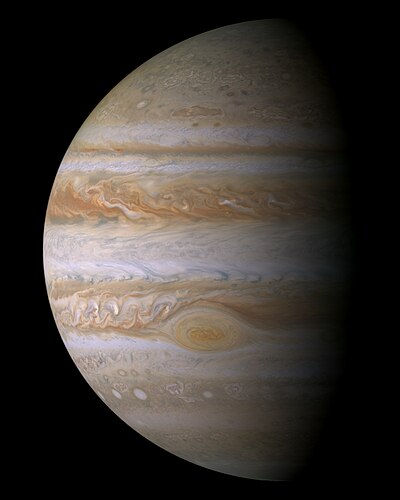
Credit: Cassini probe
Jupiter is the fifth planet from the Sun and by far the largest within the Solar System. It is 318 times more massive than Earth, with a diameter 11 times that of Earth, and with a volume 1300 times that of Earth. Its best known feature is the Great Red Spot, a storm larger than Earth, which was first observed by Galileo four centuries ago. This picture, taken by the Cassini orbiter was one of 26 thousand images taken of Jupiter during the course of its flyby and is the most detailed global color portrait of the planet ever produced.

